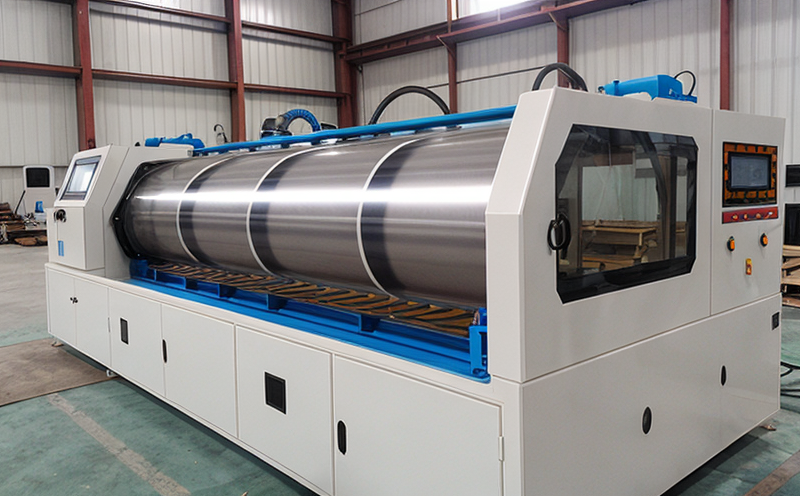DIN 53363 Coated fabrics Tear resistance testing
The DIN 53363 standard specifies a method for determining the tear resistance of coated fabrics. This test is particularly important in industries where durability and integrity are critical, such as automotive, aerospace, and construction.
This procedure involves subjecting a specimen to controlled tearing forces under specified conditions to assess its resistance to tears or rips. The test provides valuable insights into the performance characteristics of coated fabrics used in various applications.
The specimen is cut from the fabric according to predefined dimensions and must be prepared carefully to ensure accurate results. The tear test apparatus applies a load at a constant rate until failure occurs, measuring both the energy absorbed during tearing and the force required for it. Compliance with this standard ensures that coated fabrics meet specific performance criteria necessary for their intended use.
The primary purpose of conducting DIN 53363 tests is to ensure the quality and reliability of coated fabrics by identifying any weaknesses or potential failure points before they become critical issues in manufacturing or field applications. This testing method helps manufacturers optimize production processes, improve product designs, and enhance overall customer satisfaction.
In addition to assessing tear resistance, these tests also help evaluate other properties such as abrasion resistance, flexibility, and dimensional stability of coated fabrics. By incorporating DIN 53363 into their quality assurance programs, companies can ensure that their products meet stringent industry standards and regulatory requirements.
Coated fabrics are widely used in various sectors including automotive interiors, aircraft seats, building envelopes, medical equipment covers, and industrial machinery components. Ensuring the tear resistance of these materials is crucial for maintaining structural integrity and preventing costly repairs or replacements.
The DIN 53363 standard has been adopted by many organizations around the world due to its reliability and accuracy in measuring tear resistance. Compliance with this standard provides confidence that products will perform consistently across different environments and applications.
Our laboratory uses state-of-the-art equipment and experienced personnel to conduct DIN 53363 tests according to international standards like ISO, ASTM, EN, IEC, etc., ensuring precise measurements and reliable results. Our team can provide detailed reports outlining the test procedures followed, any deviations from standard conditions, and final findings.
We offer comprehensive services for textile testing, including but not limited to colorfastness tests, mechanical strength evaluations, chemical resistance assessments, shrinkage rate determinations, and more. For those interested in learning about other related services or seeking assistance with specific projects, please feel free to contact us directly.
Industry Applications
The results from DIN 53363 tear resistance tests are essential for ensuring the performance and longevity of coated fabrics used in various industries. Here’s how this testing impacts different sectors:
In automotive manufacturing, ensuring that seat covers have adequate tear resistance is vital to prevent potential safety hazards caused by rips or tears during accidents. Aerospace applications require materials capable of withstanding harsh conditions without compromising structural integrity.
For construction purposes, using coated fabrics for building envelopes ensures protection against environmental elements while maintaining aesthetic appeal over extended periods. In medical equipment manufacturing, maintaining the integrity of coverings helps protect patients from contamination risks associated with compromised barriers.
Industrial machinery components benefit greatly from this type of testing because it allows manufacturers to identify areas prone to wear and tear early on so they can address them proactively through design changes or material selection adjustments.
Quality and Reliability Assurance
DIN 53363 testing plays a crucial role in maintaining high standards within textile manufacturing processes. By incorporating this procedure into their quality assurance programs, companies can ensure consistent performance levels across all products.
The test helps identify any flaws or weaknesses early on so that corrective actions can be taken promptly before they lead to significant issues downstream in production lines or end-user experiences. It also enables manufacturers to make informed decisions regarding raw material choices based on empirical evidence rather than assumptions alone.
Compliance with this standard demonstrates commitment to excellence among competitors, thereby enhancing brand reputation and consumer trust. Furthermore, it allows businesses to meet regulatory requirements set forth by relevant governing bodies without additional effort since compliance is already achieved through conducting DIN 53363 tests.
Environmental and Sustainability Contributions
Conducting rigorous textile testing, including DIN 53363 tear resistance assessments, contributes positively towards environmental sustainability goals by promoting the use of durable materials that last longer under demanding conditions. This reduces waste generation associated with frequent replacements due to premature failures.
Better understanding of material behavior also enables manufacturers to reduce resource consumption during production processes since they can optimize designs and minimize unnecessary inputs like excess raw materials or energy usage.
Additionally, by improving product durability through targeted improvements following DIN 53363 testing, companies contribute towards reducing landfill volumes as fewer products end up being discarded prematurely. This aligns well with broader sustainability initiatives aimed at minimizing environmental impact throughout the entire lifecycle of textile-based products.





